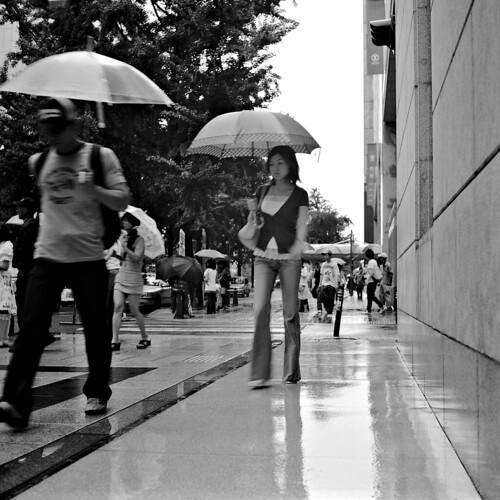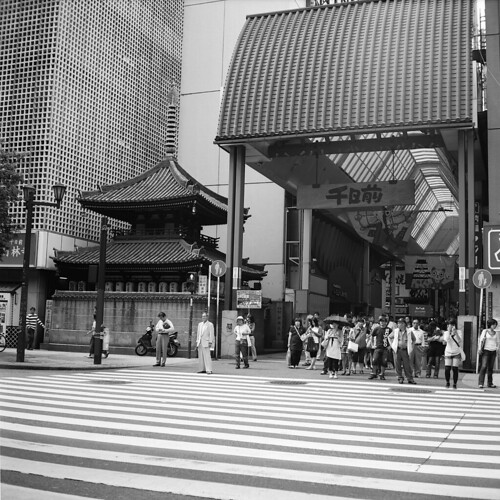Digital cameras are killing off the 35mm film format (and it already killed Polaroid film), but it has been a boon for medium-format film photography. Digital cameras, cheap scanners and the proliferation of information on the net means it is easier than ever to work with medium-format film. The continuing popularity of Holga, Diana and other toy medium-format film cameras is of course helping as well. According to photography store people in both Osaka and Stockholm (yes, two of them, total), both new and used medium format equipment has seen increasing sales for the past few years while 35mm is tanking. If you stay away from the big Brand names (Rolleiflex, Hasselblad), you can still find inexpensive and very capable used equipment.
My experience with the Yashica so far - after one roll of film - has been very positive. The camera is entirely manual of course, but easy to use; loading and unloading film, for instance, was no problem (just search the net for lots of instructions and tips). There's a light meter built in, but I've ignored it in favour of my digital camera. I use it as a light meter and "polaroid camera" for test shots. Once I'm happy with what the digital camera is showing me I can switch to the Yashica for the real shot. With only 12 pictures per roll you tend to take your time and really think things through before taking a picture. I'm certainly getting more images I'm happy with than I do with a digital camera.

They look a little silly, but lowrider bicycles are apparently fairly popular among a segment of young people here. This one is outside Sam and Dave's on sakaisuji street. Click on the image for a larger size, and you can find the full size on my Flickr photo stream.
Two things stand out with this camera: the viewfinder and the shutter. It has a glass focusing screen at the top - a big, beautiful focusing screen - that is just like having a digital camera live view, but without all its drawbacks (this really is live, after all, not recorded and shown on small screen). The viewfinder has a pop-up hood; in it is a small magnifying loupe you can flip up to check the focus precisely. The shutter is a leaf shutter (it's in the lens, not in front of the film), so it's almost silent, very fast, and produces no vibrations at all. And if you want to use flash (there's a flash socket on the camera) it will sync up to the maximum shutter speed.
There are drawbacks of course, but no serious ones. First, the viewfinder is flipped "left-to-right". As you look into the screen, it's the right side up, but your left side is on the right and vice versa. So when you want to see more of the left side of the image you need to turn right. Rather disorienting at first and takes a little while to get used to, but no big deal.
Using a separate camera to meter means you can't really react when the light changes quickly (the rain image below suffers from this); but then, this isn't a camera made for quick snapshots. The lens on the Yashica is quite good but has a few flaws. It's somewhat soft until you stop it down a fair amount, it has a tendency to flare (I need to get a hood, I think), and corners are quite fuzzy and smeared out (check the bottom corners in the bicycle image).

The rainy season - Tsuyu - is still going strong, creating fast-changing light as the weather whips back and forth between sort-of sunny and pouring rain. Film is better than digital at adapting to it, but there are limits of course.
With a camera bag over your shoulder and peering down a TLR hanging off your neck, you're not exactly Mr. Invisible. People know you're there and they know you have a big, old camera pointed at them. Nevertheless, it seems to be really good for street photography. While people easily notice you, they don't seem to be bothered by the camera the way they are with a DSLR and big lens, and the way you hold the camera means you naturally get a lower, more pleasant perspective on your subject.
Using film is not a problem either. It took me a month or so to use up my first roll, and that was with half the frames taken to test the camera. One roll is 250 yen and 500 yen to develop for a total cost of around 750 yen. Which, per month, is nothing I'd worry too much about. I could develop myself and save a bit, but really, why bother? I scan on an old flatbed scanner with a film holder (CanoScan D2400); we have a newer scanner at home but it has film holders only for 35mm, not medium format. And yes, you do want a scanner with a holder and overhead light; scanning film using the flatbed directly doesn't work.
The original scans are at 2400dpi; at that resolution the image is somewhat blurry - due to the scanner or the lens - so I downscaled them to half linear size. I could scale them larger than that, but I really don't need images that big anyway.




Hi, I've enjoyed reading many of your posts! I am headed towards Osaka in the next couple days. Is there a store you would recommend that carries cheap medium format holga-like cameras there?
ReplyDeleteHmm. You see the Holga and likes here and there (and more often than not in design stores and such, rather than camera shops), but I'd say the price is pretty much the same everywhere.
ReplyDeleteI'd go to Yodobashi Camera in Umeda; they are sure to have them. Naniwa camera in Shinsaibashi may have them as well.
But if I were you I'd skip the Holga or Diana. For a similar lo-fi effect, I'd get an old medium-format box camera instead. Cheaper, more robust and with way more street cred. Just be sure you get a 120-format camera, and ask people in the store to show you how to load film and use it before you leave, to avoid a frustrating first few times.